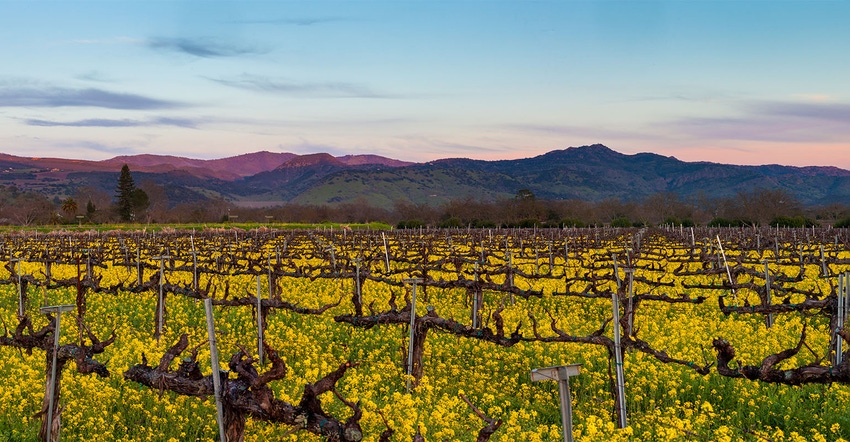September 23, 2020

Sponsored Content
After harvest, grapevines shed their green leaves and go into dormancy to tolerate cold winter temperatures and ensure flowering and vegetative growth in the spring. However, vineyard management does not stop here. Although the vines may seem quiet during this time period, there are still plenty of tasks to do during the dormancy phase to prepare for the upcoming growing season. Here are four tips from UPL to ensure healthy vines for the next growing season.
#1 Consider an Irrigation Strategy
Carefully consider a post-harvest irrigation strategy. Grapevines continue to take up carbohydrates and mineral nutrients in prep for the next season. Very dry soil can lead to a handful of issues and ultimately stunt growth in the spring. Too much water can also lead to problems. Your irrigation plan should allow the soil to store the adequate water levels it needs in order to grow properly next season.
#2 Don't Overlook Weeds
Taking control of weeds in the winter is critical because they compete with vines for nutrition and water. The largest problems for California growers are glyphosate-resistant weeds such as marestail, fleabane and ryegrass. Stopping the problem is easiest when they are still growing and measure less than 3–4 inches tall. For dependable weed control in grapes, UPL offers a portfolio of products including LIFELINE®, SATELLITE® Hydrocap and CASORON® Herbicides.
A non-selective, post-emergent herbicide, LIFELINE provides broad-spectrum weed control of some of the most challenging weeds, including glyphosate-resistant marestail, hairy fleabane, malva and filaree. Using a unique mode of action, LIFELINE inhibits glutamine production in the weeds, which leads to a breakdown in photosynthesis.
For additional weed control solutions, grape growers can consider SATELLITE Hydrocap and CASORON Herbicides. SATELLITE HydroCap delivers excellent control of grasses such as barnyard grass, ryegrass, seedling johnsongrass and witchgrass and troublesome small-seeded broadleaf weeds such as lambsquarters and waterhemp. Tank-mixing SATELLITE Hydrocap with LIFELINE in a pre-emergent application will provide burndown of emerged weeds and effective pre-emergent control in a single application.
For pre-emergent and early post-emergent needs, CASORON is an excellent choice for control of glyphosate-resistant marestail, fleabane and ryegrass, as well as other hard-to-kill weeds such as Bermudagrass, bindweed and horsetail (Equisetum spp.). CASORON is a broad-spectrum pre-emergent and early post-emergent herbicide that provides a highly effective, long-lasting, non-selective herbicidal barrier that controls both germinating seeds and young, existing weeds by inhibiting growth of roots and shoots.
#3 Dust Off the Pruning Shears
Pruning is one of the most important vineyard operations of the year because it lays out the foundation for vine management throughout the rest of the growing season. According to the Napa Valley Register, pruning can reduce the number of buds to a reasonable number that promotes balance between shoot growth (vigor) and number of grape clusters (yield). However, the responsibility lies on the pruner to balance and space the buds. Pruning can take place as early as November (after leaf drop) and as late as March (before bud break), but timing will vary depending on climates.
It’s important to note that pruning creates a wound on the vine that can act as an entryway for damaging fungi such as Eutypa dieback, or grapevine trunk disease. Once the spore lands on the vine’s open wound, it settles into the wood. TOPSIN® M WSB Fungicide (FRAC M1) is your go-to brand if Eutypa dieback is your disease concern. TOPSIN is a systemic fungicide that moves from top to bottom, and upward and outward within the leaves and stem. It is recommended that TOPSIN be rotated with fungicides in different FRAC groups. Use of TOPSIN M WSB for Eutypa dieback is approved for use under specific state local-need labels. TOPSIN should be applied to the wounds following pruning to protect the vine when it is most susceptible to infection.
#4 Avoid Overwintering Disease
Damaging diseases such as Botrytis bunch rot remain a high threat through post-harvest. Botrytis bunch rot overwinters as sclerotia, which are hard, resistant structures sometimes referred to as "berry mummies." Following rain or irrigation, sclerotia germinate and produce spores that travel by air currents or rain showers. Most often, fungal spores require free water for a specific period of time before they can germinate. Late-season infections are most severe when temperatures range from 58 °F to 82 °F, relative humidity exceeds 92 percent and free moisture is present on the fruit surface.
Grape growers use fungicides like ELEVATE® and PH-D® to protect current fruit and minimize the potential future effects of overwintering Botrytis bunch rot and give grapevines a solid foundation leading into the next growing season.
ELEVATE Fungicide (FRAC Group 17) provides locally systemic activity and is excellent at controlling Botrytis bunch rot and powdery mildew. ELEVATE can provide post-infection activity when applied early in the disease life cycle and has been shown to enhance the efficacy of other fungicides when used in a powdery mildew spray program. With a zero-day pre-harvest interval, you can use ELEVATE up to the day of harvest.
PH-D Fungicide (FRAC Group 19) is a broad-spectrum fungicide that offers a high degree of Botrytis and powdery mildew control in grapes. Its benefits of a zero-day pre-harvest interval and 4-hour REI make it an excellent option for disease management sprays close to harvest. PH-D is the only product in FRAC Group 19, making it an important resistance management tool.
What happens in your vineyard during dormancy can affect the next growing season. UPL has a portfolio of products that you can count on. To learn more about the UPL portfolio of crop protection products, contact your local UPL sales representative or visit www.upl-ltd.com/us.
Always read and follow label directions. UPL, the UPL logo, OpenAg and all products are trademarks of a UPL Corporation Limited Group Company. ©2020 UPL Corporation Limited Group Company. UPL-2011K
You May Also Like




